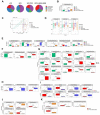Multiple Selection Criteria for Probiotic Strains with High Potential for Obesity Management
- PMID: 33668212
- PMCID: PMC7995962
- DOI: 10.3390/nu13030713
Multiple Selection Criteria for Probiotic Strains with High Potential for Obesity Management
Abstract
Since alterations of the gut microbiota have been shown to play a major role in obesity, probiotics have attracted attention. Our aim was to identify probiotic candidates for the management of obesity using a combination of in vitro and in vivo approaches. We evaluated in vitro the ability of 23 strains to limit lipid accumulation in adipocytes and to enhance the secretion of satiety-promoting gut peptide in enteroendocrine cells. Following the in vitro screening, selected strains were further investigated in vivo, single, or as mixtures, using a murine model of diet-induced obesity. Strain Bifidobacterium longum PI10 administrated alone and the mixture of B. animalis subsp. lactis LA804 and Lactobacillus gasseri LA806 limited body weight gain and reduced obesity-associated metabolic dysfunction and inflammation. These protective effects were associated with changes in the hypothalamic gene expression of leptin and leptin receptor as well as with changes in the composition of gut microbiota and the profile of bile acids. This study provides crucial clues to identify new potential probiotics as effective therapeutic approaches in the management of obesity, while also providing some insights into their mechanisms of action.
Keywords: bile acids; enteroendocrine peptides; epithelial barrier; hypothalamus; inflammation; microbiota; obesity; probiotics.
Conflict of interest statement
S.H. is employed full time by PiLeJe laboratoire and J.A. received a PhD grant supported in part by PiLeje Laboratoire. S.K. was employed by Genibio and is currently employed by Nuwen. B.P. is also employed by Yakult Europe, but declares no conflict of interests for this paper.
Figures










References
MeSH terms
Substances
Grants and funding
LinkOut - more resources
Full Text Sources
Other Literature Sources
Medical

